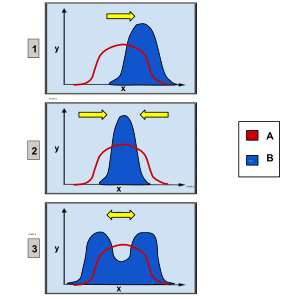Disruptive selection facts for kids

Disruptive selection, also known as diversifying selection, is a type of natural selection. It happens when individuals with extreme traits are more successful than those with average traits. This means a population can split into two different groups over time. Imagine a group where the very tall and very short individuals do well, but average-height ones struggle.
Contents
What is Disruptive Selection?
Natural selection is a key process in evolution. It explains how living things change over time. Some traits help individuals survive and have more babies. Over time, these helpful traits become more common in a population. This is because nature "selects" for the best traits in a certain environment.
Disruptive selection is special because it favors both extreme traits. It works against the average or middle trait. This can lead to a population having two very different types of individuals.
For example, imagine a bird species. If there are only very small seeds and very large seeds available, birds with small beaks can eat the small seeds, and birds with large beaks can eat the large seeds. Birds with medium-sized beaks might struggle to eat either type of seed. So, nature would favor both small-beaked and large-beaked birds, but not the medium-beaked ones.
This type of selection can cause a population to split into distinct groups. It often happens when different groups within the same species start using resources in different ways.
Rabbit Fur Example
Let's look at an example with rabbits to understand disruptive selection better.
Imagine a group of rabbits where fur color is controlled by two genes.
- A rabbit with two "B" genes (BB) has black fur.
- A rabbit with two "b" genes (bb) has white fur.
- A rabbit with one "B" and one "b" gene (Bb) has grey fur.
Now, picture these rabbits living in an environment with areas of black rocks and areas of white rocks.
- Black rabbits can easily hide from predators among the black rocks.
- White rabbits can easily hide among the white rocks.
- Grey rabbits, however, stand out against both black and white rocks. They are easy targets for predators.
Because of this, the grey rabbits are eaten more often. Over time, there will be fewer grey rabbits. The population will have mostly black rabbits and white rabbits. This is disruptive selection at work: the extreme fur colors (black and white) are favored, while the middle color (grey) is not.
How New Species Can Form
Scientists believe disruptive selection is a major reason why new species form, especially when they live in the same area. This process is called sympatric speciation.
Here's how it can happen: 1. Different Traits are Favored: Disruptive selection causes a population to develop two distinct groups with different traits. 2. Less Competition: If these two groups start using different resources or living in slightly different ways, they compete less with each other. For example, one group eats small seeds, the other eats large seeds. 3. Mating Choices: Over many generations, individuals in one group might start preferring to mate only with others from their own group. This is called assortative mating. If black rabbits only mate with black rabbits, and white rabbits only mate with white rabbits, they stop mixing their genes. 4. Reproductive Isolation: Eventually, the two groups might become so different that they can no longer have fertile offspring together. At this point, they are considered separate species.
This process is more likely to happen in crowded populations. When there are many individuals, competition for resources is high. This pressure can push groups to specialize and avoid competing with each other, leading to disruptive selection.
Other Outcomes
Disruptive selection can also lead to:
- Polymorphism: When a species has two or more clear forms or types.
- Sexual dimorphism: When males and females of the same species look very different from each other (e.g., peacocks).
- Phenotypic plasticity: When an organism can change its traits based on its environment.
Why It's Important
Disruptive selection is important in the study of evolution. A famous example is Darwin's finches in the Galápagos Islands.
Charles Darwin noticed that different finch species on the islands had very different beak sizes. He thought they all came from one original finch species. The finches with big beaks ate big seeds, and those with small beaks ate small seeds. Finches with medium beaks had trouble eating either type of seed. So, the medium-beaked finches were not as successful. This is a classic example of disruptive selection favoring the extreme beak sizes.
While disruptive selection can lead to new species, it's often a slow process. It involves small changes building up over a long time. This is known as phyletic gradualism. It's different from directional selection, where only one extreme trait is favored, which can lead to faster changes in a population.
See also
 In Spanish: Selección disruptiva para niños
In Spanish: Selección disruptiva para niños
- Character displacement
- Balancing selection
- Directional selection
- Negative selection (natural selection)
- Stabilizing selection
- Sympatric speciation
- Fluctuating selection
- Selection


